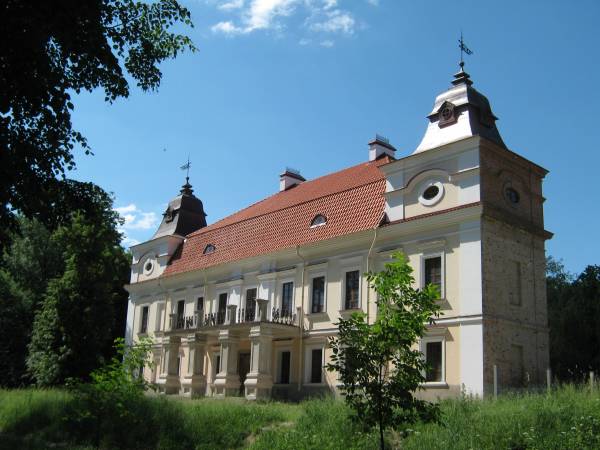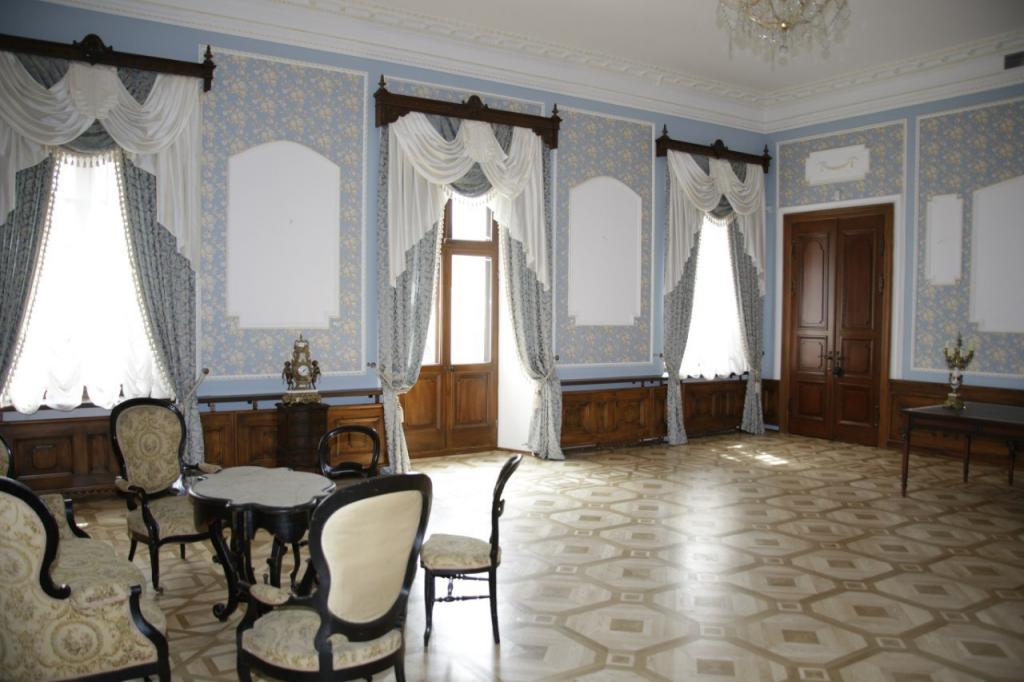Museum "Nemtsevich Manor" is a unique monument of architecture in the late Baroque style. In Belarus, few surviving estates have survived, most of them died in the crucible of the war. The restored palace and patrimonial estate of the Polish gentry, who lived on this land for several generations, is all the more valuable.
Famous Nemtsevich family
The first mention of the family of the Nemtsevichs belong to the XVI century. Initially, the family bore the surname Ursyn, which is translated from Latin as "bear". This beast is depicted on the coat of arms of an ancient gentry. Since the XVII century, the Ursins decided to designate their origin from the Germans, adding the word Nemtsevichi to their surname.
It is known that the forefather was the steward Jerzy Ursyn. The first famous heir was his grandson Casimir, who married Kristina Delovitskaya. The offspring of this union, Andrei Jan, served as ambassador of the Warsaw Sejm, being the representative of the Spony Council. In due time, Andrei married Sophia Godlevskaya, their son Alexander added the Skoki village to his family estates, in which a beautiful family mansion was later built.
The village of Skoki became the patrimony and place of the family nest of Marcelius Ursyn-Nemtsevich. He married Yadvig Sukhodolskaya, 16 children were born in the marriage. After the death of the parents, the estate passed to the eldest son Julian, who became one of the famous figures of his time. He was a writer, politician of the Commonwealth. In 1890, the estate, consisting of 319 acres of land, belonged to Ivan Nemtsevich.
In 1905 it was inherited by the son, and in 1923 the estate and land belonged to Sophia Pilecka, who came from the family of the Nemtsevichs. Until 1939, the estate was home to the writer Stanislav Ursyn-Nemtsevich, later it was nationalized. Representatives of the Nemtsevich clan left Russia and settled in Europe. Today we can say that the clan almost ended.
Architecture
The estate of the Nemtsevichs in Skoki, according to the latest researchers, was built in 1777. Who was the author of the architectural project remains unknown. Some historians believe that they could be a specialist from Warsaw. The manor and park ensemble initially consisted of a manor house in two floors, several outbuildings and a luxurious park designed on a regular basis. Park alleys led the traveler to the banks of the Lesnaya River. Opposite the main house, a tomb church was built, which became the last refuge of several generations of owners of the Nemtsevich estate, after the Great Patriotic War, it was demolished.

The ancestral mansion was built in the power of the late Baroque and was a two-story building of a rectangular shape. The upper floor was crowned with a tiled mansard roof, the decoration of which was two symmetrical side alkegs on both sides of the house. Two entrances led to the mansion - the central one and from the side of the park; their main decoration was the terrace. For decades, the mansion was in an abandoned state, restoration work was started in 2006. Today, several rooms of the mansion are open to the public.
Estate History
The Nemtsevich manor (Brest) is the only architectural heritage of this kind that has been preserved in good condition to this day in the vicinity of Brest. For several centuries, it was home to a family of Polish gentry. Over the years, eminent guests have been here - Tadeusz Kosciuszko, Adam Czartoryski, Emperor Alexander III, Jan Fleming and other fate-makers, cultural figures, writers, musicians.
The house survived several major ruins, but remained almost unscathed. In the palace at the beginning of the twentieth century, drawings of Leonardo da Vinci, van Dyck and other artists were kept. The Ursyn-Nemtsevichs owned unique artifacts, such as Napoleon's cigarette case, an autograph of George Washington and many others. Some of them were taken abroad by the family, and some died in the millstones of revolutionary times and wars.
During the First World War, the estate became the headquarters of Prince Leopold of Bavaria, who commanded part of the German front. It was here that the 1917 military truce was signed between Russia and Germany. A reminder of this event was a monument to the conclusion of the contract in the estate of the Nemtsevichs in Skoki.
The Germans left the estate after 1939. The reason for the emigration was the entry of the regions of Western Belarus into the BSSR. After the Great Patriotic War, a boarding school was located in the main house of the estate. In 2010, the pupils were transferred to other institutions, and work began on the building of the memorial museum-estate of the Nemtsevichs in the building.
Modernity
The official opening of the museum "Nemtsevich Manor" took place in 2013, but at that time the building had been in desolation for several years. General construction and restoration work was carried out in 10 halls of the palace, which ended in 2015. Today, excursions are held at several expositions, in the future plans is the restoration of another 10 halls. The museum will be decorated stands, music living rooms, a library, an art salon, exhibition halls and much more.

Unfortunately, the property that Nemtsevichi owned was not preserved. In 1915, the whole situation was evacuated to Kaluga, away from the front of the First World War, but traces of the cargo were lost. All exhibits presented in museum halls open for visitors are bought by employees specifically for the estate at auctions and from private individuals. The exposition is designed to demonstrate a typical way of life, the device of life of representatives of the ruling class of the gentry. By 2017, 6 halls of the second floor were available for visiting.
Current exposition
Several expositions are open to the public - an armory, a bedroom, an office, a dining room, a front and music halls. Several separate rooms are dedicated to the most famous representative of the Nemtsevich clan - Julian. As a writer, poet, public and political figure, he left a huge mark in the culture of Belarus and Poland. Not only employees and ordinary citizens, but also customs services actively participate in the formation of the exposition, some of the valuable items were transferred from the regional museum.
After the opening, the Nemtsevich Manor Museum became a cultural center, on the basis of which events that have become traditional are held. Balls are popular with the public, where the spirit and surroundings of the gentry leisure are recreated. Also an annual event held within the walls of the palace is the military-historical festival, reconstructing the signing of the armistice of Russia and Germany in 1917.
What to see
Of the entire interior of the Nemtsevich estate, only the cast-iron staircase is well preserved. Its parts were found in the basement, the missing parts were cast in whole samples and installed on a historic site. Of the things sent to Kaluga, a small part of the paintings from the Nemtsevich collection was preserved, but they are exhibited in the museum of Kaluga.
At the end of the 80s of the last century, not far from the city of Grodno, border guards stumbled upon a treasure once made by the Nemtsevichs who had left the country. It contained a mace, silver utensils, an old saber - these items are in the museum, but most of the treasure has disappeared. Today, the interiors of the 19th century are recreated in the halls of the estate. In the armory, visitors can admire armor, a collection of knives, crossbows, and bear skins.
The blue living room is dedicated to the reception hall; antique furniture, a piano, and a grandfather clock with a fight are on display here. The director of the museum said that some of the halls are inaccessible to the public due to the fact that they do not have an exposition, but all restoration work has already been completed. The administration annually purchases more than 100 units of valuable items from private individuals at auctions, much is passed by customs.
Not so long ago, customs officers seized 10 unique items at the border and transferred 10 unique items to the Nemtsevich manor — a china carriage, several paintings, watches and much more. The museum notes that the flow of tourists is constantly increasing: for example, only in the first half of 2018, the exhibition was visited by 7 thousand people.
To participate
In the estate of the noblemen of the Ursyn-Nemtsevich, party parties, concerts, balls and other celebrations were often held. The administration of the museum decided to revive old traditions, so visitors can take part in interesting events. Unprecedented excitement caused the possibility of photo shoots in historical interiors, there is no end to the newlyweds, the queue is scheduled for several months in advance.
Balls held in historic interiors have become traditional. The New Year's ball in the Nemtsevich manor in 2019 gathered more than 100 guests. The main requirement for the participants was to observe the rules of etiquette of the 19th century, which includes the appropriate costume, the ability to maintain conversation and the desire to dance. After the ball, the guests went for a sled walk in the park. This year several more similar events are planned, everyone can take part.
The Museum "Nemtsevich Manor" is located in the village of Skoki, Brest region, on Mira street, building 46B.
The museum is open from Tuesday to Sunday from 10:00 to 19:00. The cost of visits for adults is 2.50 rubles, for pensioners, students and children discounts apply. On every last Tuesday of the month, the museum can be visited for free.